Dirac's Cambridge and Newton's Cambridge

|

|
- I also made many webpages about his physics as well as his personality. The
most popular among those is the page
comparing him with Richard Feynman.
As you know, Dirac published most of his papers from St. Jones College of Cambridge. I went to Cambridge in 1993 expecting to have a photo with his statue, but I was not able to spot his name. Indeed, the College reflects Dirac's personality: very quiet and not willing to talk to anyone.
- In June of 2016, while I was spending four days of rest in London after a
trans-Atlantic flight from Boston (USA), I went to Cambridge again to find
Paul A. M. Dirac. Again, St. John's College was quiet. and I was not able to
see anyone. Then suddenly, I met a young professor at the Second Court of the
College. His name is Mete Atature. You are invited to
his home page. His
recent publications include a
Letter in the Nature.
I met Mr. Atature in 1998 while attending a quantum optics conference held in Evanston near Chicago. He was a graduate student at Boston University then. I was so happy to see him again and to note that he became a full professor at Cambridge. He is still so young, and we certainly expect much more from him.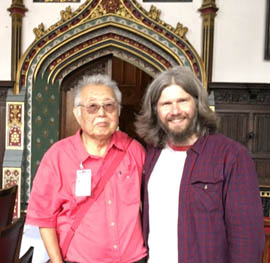
Professor Atature was on his way to a committee meeting when we met, but he spent enough time to guide me to Dirac's portrait in the Formal Dining Hall of the College. I hope he was not too late at his meeting. He had a photo with me in the Hall, and he was kind enough to post the photo on his face book.
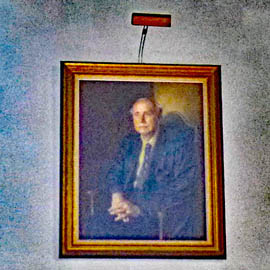
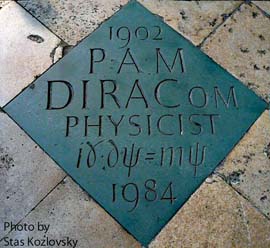
- Indeed, there was a large portrait of
Paul A. M. Dirac on the wall of the Hall.
- I was so happy to see him that I had a photo of myself standing underneath his portrait.
- For this opportunity, I am indeed grateful to Mete Atature for guiding me to this spot. I had a photo with him in front of Dirac's portrait. We look OK in this photo.
- There has been and still is Dirac's bust in the Fine Hall Library of Princeton University. In 2013, I was fortunate enough to go there again and have this photo of myself with Dirac.
- There is also a bust of Dirac in the main lobby of the physics building of the Imperial College of London.
- In the history hall of London's Westminster Abbey, there is Dirac's name plate in front of Isaac Newton's tomb.
- Dirac's grave is at Roselawn Cemetery in Tallahassee, Florida, U.S.A. Dirac left us in 1984, and the his memorial convocation was held at Florida State University in November of 1984. I went to this to this convocation.

- This Formal Dining Hall seems to have a long history. It is located
between the first and second courts of the College.
- Click here for its exact location.
- This is a photo of photo of the hall and Chapel seen from the First Court of the College.
- The Hall was empty and was like this when we went in.
- The ceiling of the Hall looks like this.
- The Hall is like this when the
formal dinner takes place.
- During World War II, American and British war planners used this Hall as a secret place to plan the Normandy Landings of 1944 which turned the tide of the war.
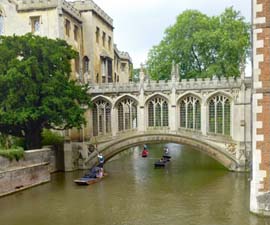
- Other interesting places of St. John's College include
- Front Gate of the College. What is wrong with this gate is that they charge admission fees to visitors.
- Tower and Gate of the Second Court leading the Third Court. I was there in 1993.
- The Bridge of Sighs across the Cambridge River, leading from the eastern (old) to western (new) territory of the College. This photo was taken in 2016 from another bridge called Kitchen Bridge about 20 meters south. I was there in 1993.
- New Court on the west bank of the River Cam.
- Click here for more photos of and stories about St. John's College in Cambridge, UK.
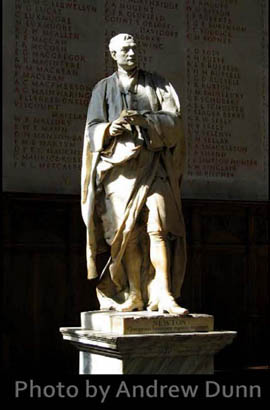

-
Trinity College is just south of St. John's College. What is so great
about this College?
- Sir Isaac Newton was a student there and later became a fellow of this College.
- Newton's statue is in the chapel of this College, but I could not enter the Chapel to have a photo with him, when I was there in 1993 and 20016.
- I had a photo with his bust in a museum at Kensington Gardens in London. Click here for the photo. Newton was with his apples.
- There is a statue of Newton
in front of the
British Library in London.
- Newton's grave is in the history hall
of
Westminster Abbey. We are not allowed to operate cameras in this hall.
However, I took this photo with a telephoto lens from an area where cameras
are not forbidden. There is a close-up photo of this grave in the public
domain. Click here.
On the floor in front of his grave, there are name plates for Michael Faraday, William Thomson (Lord Kelvin), George Green, James Clerk Maxwell, and P. A. M. Dirac.
- Until 1995, one-pound bill of English money carried a portrait of Isaac Newton, on its back. These days, only coins are available for one pound without Newton. They should restore Newton on the back of the coin.
- This is the
Great Court of Trinity College. This map tells how big
the Court is.
- The Fountain is at the center of the Court.
It appears that this fountain served as a important source of drinking water
before the Industrial Revolution. With its roof, this structure must have
been a well with a deep hole in the ground.
When Newton drank water from this well, he must have thought about how his gravity law works inside the sphearical earth by dropping a stone (not a trivial problem). He could have dropped an apple instead of the stone, but he did not want to pollute the water. I do not know whether this really happened, but I am happy to make up this story and choose to call this place Newton's Well.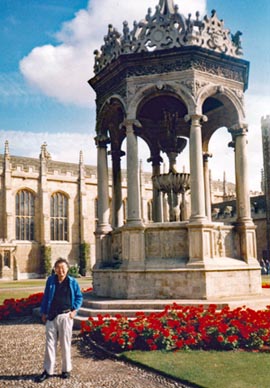
- In 1993, I was there to take this photo
of Newton's Well and the Great Court. I did not have a good camera
at that time. In this photo, I am standing
next to the Well.
- When I was there, I did not realize I belong to Newton's genealogy.
Michael Ruiz received his PhD degree from the University of Maryland in 1978,
and I was his thesis advisor.
In July of 2016, he sent me a letter telling me he belongs to Newton's genealogy, and sent me the genealogy tree. His name is there as well as mine. You will be interested to see Steven Weinberg's name there.
If you do not see your name, you should be able to add a branch with your name.
For many years, Ruiz served as the chairman of the physics department at the Univ. of North Carolina in Asheville, and is now a senior professor there. He had and still has many different talents.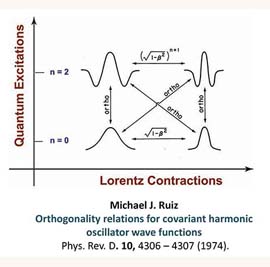
While he was a student, Ruiz did an important calculation and published the result in Phys. Rev. D. It tells how the harmonic oscillator wave functions become Lorentz-contracted. Einstein told us how a rigid rod becomes contracted. Do you know how wave functions become contracted? Click here for what Ruiz says in his paper, and his photo. He also a good father.
- The Fountain is at the center of the Court.
It appears that this fountain served as a important source of drinking water
before the Industrial Revolution. With its roof, this structure must have
been a well with a deep hole in the ground.
- There are many other colleges and laboratories. Cavendish Laboratory,
Clare College, Churchill College are among the names familiar to physicists.
Frankly, I do not understand why there should be so many colleges under one
university system, but I am not the first one to have this trouble.
- John Witherspoon
was the sixth but founding president of Princeton University. He came from
Scotland and became one of the signatories of the American Declaration of
Independence.
Witherspoon was a Presbyterian clergy man but had many progressive ideas. He developed his geograph of multi-college university system. He thus developed the concept of "campus" and started using this word. You are thus invited to visit my webpage for Witherspoon's Princeton campus.


- Another problem with Cambridge is a lack of recreational resources. Yes,
there is a river called River Cam.
Cambridge produces spectacular scenes on graduation days. It is of course fun to talk with students with various backgrounds.
Yet, Cambridge is only for studying, and nothing else.
- Thus, the city of London is the ultimate destination for recreation.
It takes two hours by the hourly express train called
Great Northern.
The Cambridge Railway Station
is not within a walking distance from the colleges. In 1850, the city
of Cambridge located this station far away from the colleges in order
to discourage students to go to London. Things are somewhat different
these days. There are city buses.
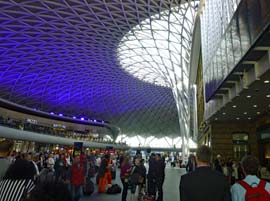
- The train stops at the
Kings Cross Station in London.
London is of course a great city for all purposes. However, if you are so used to it, you can move to the next building to board a train at the St. Pancras Station to go to Paris. The world is small these days.
- I can understand how boring academic towns are. I spent four years in Princeton as a graduate student and a post-doc. Princeton was and still is a dry town. Thus, I had to take one-hour train ride to New York to satisfy my extra-curricular needs. I still go there often to update my webpage for New York.

- John Witherspoon
was the sixth but founding president of Princeton University. He came from
Scotland and became one of the signatories of the American Declaration of
Independence.
- I still have more photos for this page. I will post them when I have time. Please come again.
- copyright@2016 by Y. S. Kim, unless otherwise specified.
The photo of Dirac and Feynman is from the Caltech Photo Archive. This photo was taken by Marek Holzman during the International Conference on Relativity Theory of Gravitation in Warsaw (Poland) on July 25-31 1962, organized by Leopold Infeld.
How did I talk to Einstein? - Click here for his home page.
- His photo-biography.
- His Einstein page.
- His Princeton page.
- His Style page.

I received my PhD degree from Princeton in 1961, seven years after high school graduation in 1954. This means that I did much of the ground work for the degree during my high school years.